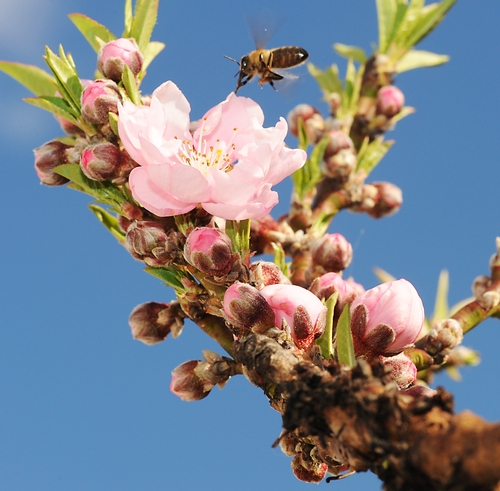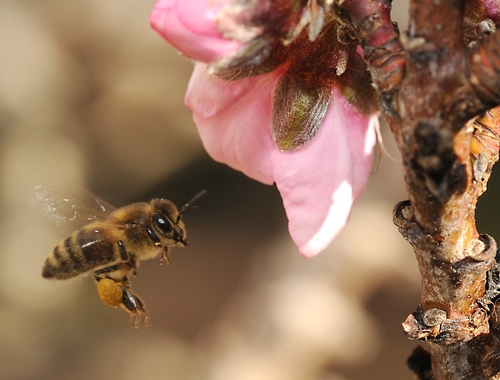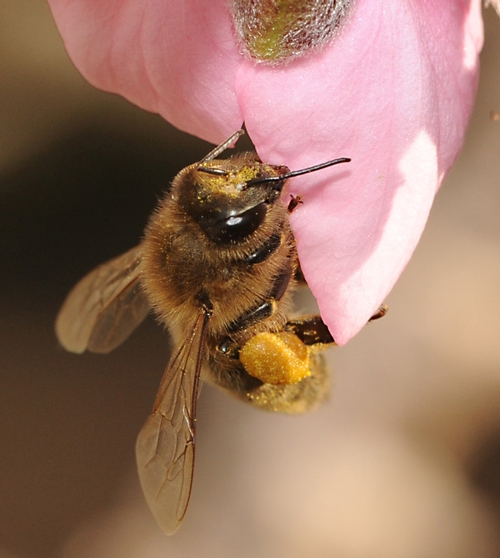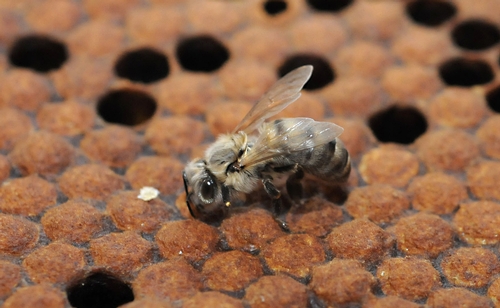From the UC Blogosphere...
Dormant Sprays
By Yvonne Rasmussen, U. C. Master Gardener
What are dormant sprays and what are they used for? In Napa Valley, most deciduous fruit trees benefit from these protective treatments, applied in winter after leaves have fallen and before new growth has fully emerged.
Dormant sprays help control many insects and fungal diseases. Applied in winter, when some insects are in their most vulnerable stage (crawlers or eggs) and many fungi are at their most active, these sprays can be highly effective. Spraying trees when they are bare helps you get good coverage of branches and insects, key to good control. Sprays can damage tender young growth, another reason to apply them when trees are dormant.
Some dormant-season sprays are fungicides. Others are horticultural oils derived from highly refined petroleum. When applied in the dormant season or early spring, before bud break, horticultural oils help control scale, spider mites and leaf-chewing caterpillar eggs. They can also help eliminate sucking insects such as plant bugs and aphids when they are immature and present in high numbers. Later in the summer, you can use these oils to control spider mite eggs and adults on leaves.
Most experts agree that horticultural oils kill insects by smothering them. The fine droplets coat tender-bodied insect and egg surfaces, preventing oxygen uptake. The spray must fully coat branches, including those little nooks and crannies where small insects and eggs can hide. If you don’t get good coverage, or if the insects or eggs are in a protected stage of growth, such as a hard-shell stage or cocoon, you will not get good control. Note that oil residue will not harm beneficial insects that may fly into the area after you spray.
Look for horticultural oils at nurseries and garden centers, where they are often labeled as “superior oil” or “summer spray oil.” They generally flow easily and have low sulfur content so you can use them on growing plants in winter or summer, but not on tender new growth.
Fungicides protect fruit trees by inhibiting fungus growth that might infect branches. These products are generally composed of copper or sulfur or some combination of the two. Again, good coverage and timing are critical. You need to apply fungicides before fungi are actively growing. And if it rains, you must reapply them to keep plants protected. As a result, you may need to treat your trees several times in early spring to protect new growth. Once the fungus is actively growing, it is too late for effective control or treatment.
Our wet weather and mild temperatures encourage fungi growth. Many of our fruit trees (such as pear, apple, peach, prune and apricot) are especially susceptible. If properly applied, copper and sulfur sprays can help protect trees from such problems as leaf curl, scab, powdery mildew, anthracnose, cankers and bacterial blights. To be most effective, fungicides should be applied in the fall, around November, and again in the spring before buds swell, usually early February. In a dry year, you can forego the February treatment. In wet years, you may need a third spray near bloom time.
Good tree care throughout the year is also important in keeping fungal problems at bay. Thinning the canopy in midsummer will improve air flow. Removing diseased wood and plant parts during winter pruning will also help control disease.
Keep pruners clean and sharp. When using any chemical or pesticide, follow label directions exactly, including instructions for clean-up and disposal. Read the label before you start.
For more information on dormant spraying and other fruit-tree topics, consult the Master Gardeners’ Healthy Garden Tips (http://ucanr.org/sites/ucmgnapa/Gardening_Books/Healthy_Garden_Tips/) and Pest Notes (: http://www.ipm.ucdavis.edu/PDF/PESTNOTES/index.html). For more information about home fruit trees, consult the University of California’s backyard-orchard web site (http://homeorchard.ucdavis.edu/).
March Gardening Chores
March Garden Chores By Maggie King, Master Gardener Photo by Jennifer Stevens. A blanket of Baby Blue Eyes covers a...
Nectarines Bursting Into Bloom
It's Presidents' Day and far too early for nectarines to burst into bloom.The unseasonable weather, however, fooled...

Nectarine Blossoms

Caught in Flight

Lots of Pollen
A Weighty Matter in the Hive
Think what it would be like if you increased your weight by 1000 times in six days. But that's exactly what worker bee...

Honey Bee Cells

Queen Bee

Newly Emerged Bee
Roundup Ready alfalfa news and a news roundup
Late last month, USDA once again deregulated genetically modified alfalfa. The action prompted extensive news media coverage, with many articles centering on outcry from organic growers who are not comfortable with the idea of GMO/non-GMO coexistence.
According to a DTN blog, UC Davis Cooperative Extension alfalfa specialist Dan Putnam said he doesn't believe the deregulation puts organic alfalfa at risk.
"I don't believe it is certain. I believe it is something we can manage and prevent," he said.
Putnam's research results on alfalfa cross-contamination were noted in a blog on The Atlantic. A 2008 study found that when a Roundup Ready alfalfa seed crop and a non-Roundup Ready hay crop were grown 160 feet apart, the rate of successful gene flow from GM seed crop to non-GM hay crop was 0.25 percent - considered a small risk.
Nevertheless, Putnam said USDA's deregulaton decision likely won't put the controversy to rest.
"There's no question the lawsuits will continue. They would probably continue regardless of whichever way they went," he was quoted.
News roundup
Here are a few news stories that appeared this week that touched on ANR:
Sumo citrus. LA Times freelance food writer David Karp introduced readers to a new citrus variety, the Sumo. "Think of a huge mandarin, easy to peel and seedless, with firm flesh that melts in the mouth, an intense sweetness balanced by refreshing acidity, and a complex, lingering mandarin orange aroma," Karp wrote. "I've tasted more than 1,000 varieties of citrus, and to me the Dekopon (Sumo) is the most delicious." The Citrus Clonal Protection Program at UC Riverside played a role in making the Japanese fruit available to Americans by cleaning imported budwood to be sure it is free of diseases, a process that took several years.
Garden recycling. The L.A. At Home blog in the LA Times outlined ideas for putting recyclables to work in the garden, gleaned from Yvonne Savio, the manager of the LA Master Gardener program. The post illustrates a compost bin made of rusty bedsprings, an old bathtub turned into an ornamental shade garden, aluminum roasting pans that were recycled into seed-starting trays and plastic water bottles that double as water channeling containers.
Cheaters never prosper. In a move aimed at ending cheating at farmers' markets, the CDFA is proposing a significant fee hike for vendors - from 60 cents to $4. The $4 fee would raise about $1.5 million annually, much of which would be used to hire full-time CDFA officers based in Northern, Central and Southern California to conduct farm and market inspections, according to the LA Times.
Creating jobs. The head of USDA's Rural Development office in California visited Santa Cruz County to offer her agency's help to create jobs, said a story in the Santa Cruz Sentinel. "As a nation we have hemorrhaged jobs," said Glenda Humiston. "The jobs we've lost, virtually none of them are coming back." Pointing to positive steps to alleviate the problem, she noted that the Center for Regional Change at UC Davis is studying ways to innovate financial systems to invest local money locally.







